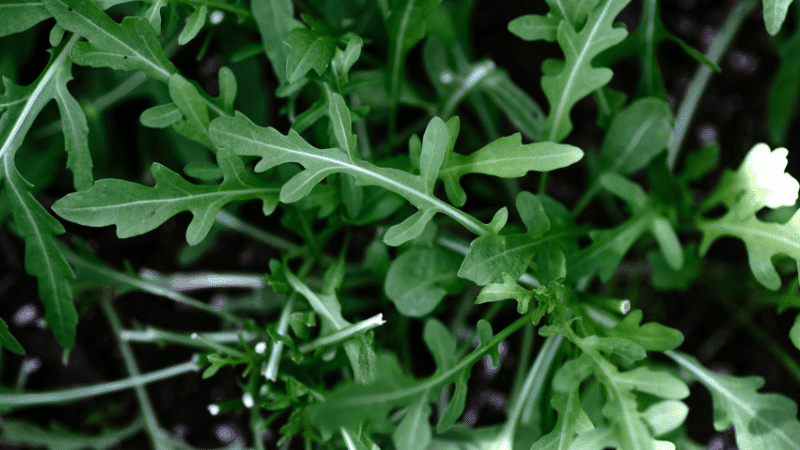Arugula, with its peppery flavor, is a popular leafy green in many gardens. Companion planting with arugula involves selecting plants that mutually benefit each other, whether through pest control, nutrient sharing, or other synergistic effects.
Understanding which plants are beneficial or detrimental to arugula can significantly enhance your garden’s health and yield.
Benefits Of Companion Planting with Arugula
- Pest Control: Certain companions can deter pests that commonly affect arugula.
- Soil Health: Some plants improve soil conditions, benefiting arugula’s growth.
- Flavor Enhancement: The presence of specific plants can subtly influence arugula’s flavor.
- Spatial Efficiency: Proper companion planting maximizes space and reduces weed growth.
Good Companion Plants for Arugula
Plants that complement arugula often provide pest control or improve soil nutrients. Here’s a list of 10 good companions:
| Plant | Benefit to Arugula |
|---|---|
| Basil | Deters pests |
| Garlic | Repels aphids |
| Onions | Pest control |
| Cucumbers | Improves soil moisture |
| Mint | Repels insects |
| Rosemary | Deters pests |
| Nasturtiums | Attracts beneficial insects |
| Beets | Uses different soil nutrients |
| Spinach | Similar growing conditions |
| Carrots | Enhances flavor |
Basil

Basil is an excellent companion plant for arugula as it can deter pests like aphids, mosquitoes, and fruit flies. The strong scent of basil is unappealing to many garden pests, making it a natural insect repellent. Additionally, basil and arugula have similar growing requirements, making them well-suited for companion planting.
Garlic

Known for its pungent aroma, garlic is a natural pest repellent that can help protect arugula from aphids and other common garden pests. When planted near arugula, garlic can release compounds that deter insects while also improving soil quality with its nutrient-rich bulbs.
Onions

Like garlic, onions are effective at repelling aphids and other insects that may harm arugula plants. Their strong scent can confuse and deter pests, making them an excellent companion for arugula. Onions also have a shallow root system, allowing them to grow well alongside arugula without competing for the same nutrients.
Cucumbers

Cucumbers can be a beneficial companion for arugula as they help improve soil moisture levels. Cucumber plants have a sprawling habit and large leaves that can shade the soil, preventing excessive evaporation. This can help maintain consistent moisture levels, which is essential for the growth of arugula.
Mint

Mint is a fragrant herb that can repel insects like ants, aphids, and flea beetles, making it a useful companion for protecting arugula plants. However, it’s essential to contain mint’s aggressive growth by planting it in containers or raised beds, as it can quickly spread and become invasive.
Rosemary

Rosemary is a hardy herb that can help deter pests like cabbage moths, beetles, and carrot flies when planted near arugula. Its strong aroma and woody stems create an inhospitable environment for many garden pests, while its deep roots allow it to grow alongside arugula without competing for resources.
Nasturtiums

Nasturtiums are known for attracting beneficial insects like ladybugs and lacewings, which prey on aphids and other pests that may harm arugula plants. Their bright flowers also serve as a trap crop, luring pests away from the arugula and towards the nasturtiums.
Beets
Beets and arugula are compatible companions because they have different nutrient requirements. Beets primarily consume potassium and phosphorus from the soil, while arugula relies more heavily on nitrogen. This complementary nutrient usage helps prevent competition between the two plants.
Spinach
Spinach is an excellent companion for arugula as they share similar growing conditions and have compatible nutrient needs. Both plants thrive in cool weather and well-drained soil, making them ideal for intercropping or rotation planting in the same garden bed.
Carrots
When planted near arugula, carrots can enhance the flavor of the greens by releasing a compound called terpene, which gives arugula its distinctive peppery taste. Additionally, carrots and arugula have different rooting depths, allowing them to coexist without competing for the same resources.
Bad Companion Plants for Arugula
Some plants can hinder arugula’s growth due to competition or attracting harmful pests. Avoid these 10 plants:
| Plant | Reason for Avoidance |
|---|---|
| Strawberries | Attracts slugs |
| Brassicas | Compete for nutrients |
| Fennel | Inhibits growth |
| Potatoes | Increases disease risk |
| Corn | Heavy nutrient competition |
| Cauliflower | Attracts pests |
| Broccoli | Competes for resources |
| Peppers | Different water needs |
| Eggplants | Prone to similar pests |
| Zucchini | Overcrowds and shades |
Strawberries
Strawberries attract slugs, which can quickly decimate an arugula crop. Slugs are particularly drawn to the sweet, juicy strawberry fruits and the moist, shady environment around the plants. If you grow strawberries near arugula, you’re essentially providing an all-you-can-eat buffet for these slimy pests to then move on to your arugula.
Brassicas
Brassicas like broccoli, cauliflower, kale, and cabbage are closely related to arugula, so they compete for the same nutrients in the soil. Their extensive root systems can leave little for the arugula plants. Additionally, brassicas attract many of the same insect pests that enjoy munching on arugula.
Fennel
The fennel plant releases compounds that can inhibit the growth of nearby plants like arugula. This allelopathic effect stunts the arugula and causes it to struggle and potentially bolt prematurely. Fennel’s feathery foliage also casts too much shade.
Potatoes
Potatoes increase the risk of diseases like early blight and Verticillium wilt spreading to arugula plants. The two crops are susceptible to many of the same pathogens that can travel easily between them when planted in close proximity.
Corn
Corn is often referred to as a “heavy feeder” because it requires large amounts of nitrogen and other nutrients from the soil to sustain its substantial size. Planting corn near arugula leads to fierce competition for these limited resources.
Cauliflower
Like other brassicas, cauliflower plants share pests like cabbageworms and cabbage loopers with the related arugula. An infestation can quickly spread between the two crops when they’re grown side-by-side.
Broccoli
Broccoli competes with arugula for light, nutrients, and root space in the garden bed or container. The larger broccoli plants will outcompete and overshadow the smaller arugula, stunting its growth.
Peppers
Peppers have different water needs compared to arugula. Peppers require consistent moisture while arugula prefers a swing between dry and wet soil conditions. One crop’s needs go unmet when grown as companions.
Eggplants
Eggplants are susceptible to many of the same insect pests that plague arugula, like flea beetles. Having the two plants together increases the pest pressure on both crops.
Zucchini
With their dense foliage and trailing vines, zucchini plants can easily overcrowd and shade out arugula plants nearby. The zucchini dominates the space, blocking sunlight the arugula needs.
Arugula companion plants vegetables
In vegetable gardens, choosing the right companions for arugula enhances both flavor and yield.
| Vegetable | Relationship with Arugula |
|---|---|
| Lettuce | Complementary growth cycles |
| Peas | Adds nitrogen to soil |
| Radishes | Quick growth benefits |
| Tomatoes | Balances soil nutrients |
| Asparagus | Diverse root depth |
| Green beans | Improves soil nitrogen |
| Leeks | Pest deterrent |
| Bell peppers | Neutral companions |
| Sweet potatoes | Diverse nutrient needs |
| Marigolds | Attracts beneficial insects |
Scientific References
To ensure the most accurate and up-to-date information on arugula companion plants, the following scientific references were consulted:
- Heinen, J. (n.d.). A review of previous and ongoing studies of intercropping as an alternative to fertilizers and pesticides University of Michigan biological station EEB 381: Introduction to ecology. Umich.Edu. Retrieved January 3, 2024, from https://deepblue.lib.umich.edu/bitstream/handle/2027.42/101744/kapustka_kiseleva_tryban_yates_2013.pdf?sequence=1
- Blassioli-Moraes, M. C., Venzon, M., Silveira, L. C. P., Gontijo, L. M., Togni, P. H. B., Sujii, E. R., Haro, M. M., Borges, M., Michereff, M. F. F., de Aquino, M. F. S., Laumann, R. A., Caulfield, J., & Birkett, M. (2022). Companion and smart plants: Scientific background to promote conservation biological control. Neotropical Entomology, 51(2), 171–187. https://doi.org/10.1007/s13744-021-00939-2
These references provide a deeper understanding of the interactions between arugula and its companion plants, supporting the practices of companion planting with scientific evidence.
Zaki Infitar is the driving force and creative mind behind GreenBuilt.co. As a self-taught gardener with an unwavering passion for all things green, Zaki’s journey into the world of gardening is a testament to his dedication and love for nature.

